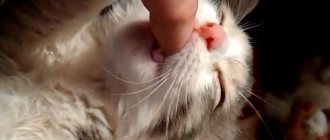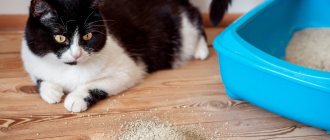Struvite can appear in a cat’s urine for a number of reasons, which sometimes indicate the progression of urolithiasis and require immediate treatment. Such a violation of the urinary system of a pet is a formation that includes salt mixtures, ions of trivalent phosphorus, calcium, ammonium and magnesium. In most cases, the problem is caused by insufficient fluid intake into the cat's body. In the early stages, it is possible to dissolve struvite stones in a cat’s urine with medications, but in advanced cases, surgical intervention will be required.
Types of uroliths
There are two types of urinary stones observed in cats:
- Struvites (Tripelphosphates).
- Oxalates are compounds of oxalic acid.
Struvite
Formed in alkaline urine. They represent a complex mixture of salts, in which ions of trivalent Phosphorus, as well as Calcium, Ammonium, and Magnesium predominate. Crystallization may be caused by dehydration.
Up to 80% of uroliths in cats are represented by Tripelphosphates. These are loose or hardened formations of yellow or cream color. Under a microscope, crystals with diamond-shaped edges are observed in the urine.
Struvite
Struvite can be dissolved with medication and is radiopaque, which makes conservative treatment of cats possible.
Oxalates
They are formed at acidic pH of urine, rapidly crystallize, and have a complex structure with sharp edges. Stones of increased hardness are difficult to dissolve, so conservative treatment is ineffective.
Oxalate urolite
Conditions for struvite formation
Struvite is formed under the influence of the following factors:
- Sufficient amount of mineral salts.
- Duration of stay in the lumen of the urinary canal.
- Ph urine > 7.0.
- There is protein in the urine.
Tripelphosphates - what is it and why are they dangerous?
Tripelphosphates in a cat's urine can only be detected in a veterinary laboratory by microscopic examination of the sediment or x-ray examination using a contrast agent. Considering the fact that not every pet owner has an idea of the mechanism of development of urolithiasis, it is worth understanding what tripel phosphates are and how they are dangerous for the animal.
Under the influence of a number of reasons, the metabolism in the cat’s body changes, urine becomes alkalized and ammonium salts of magnesium phosphate precipitate in the form of sand. Subsequently, in an alkaline environment, crystallization occurs and the rapid growth of phosphate stones occurs, which within a few days can fill the entire kidney of the animal. While tripelphosphates are in the kidney, they do not cause any disturbance to the pet due to their smooth, porous surface.
We suggest you familiarize yourself with: Blue Florida crayfish
But with the flow of urine, the stones enter other organs of the urinary system: the ureters, bladder and urethra. The main danger of stones is that they block the urethra, causing the body to lose the vital need to excrete urine.
Stagnation of urine occurs, stretching of the walls of the bladder and rupture of blood vessels, as a result of which urine toxins enter the blood, causing poisoning of the entire body. Under the influence of toxins, the functioning of the cardiovascular, respiratory, digestive and nervous systems is disrupted, a coma occurs and the animal dies in agony.
Causes
The formation of stones provokes alkalosis. This condition of urine is caused by the following reasons:
- Unbalanced cat nutrition.
- Pathology of water and salt exchange.
- Congenital predisposition.
- Hormonal imbalance in a cat.
- Adynamia.
- Infectious diseases.
- Chronic pathologies.
Types of stones
Unbalanced diet
Excess protein with a shortage of energy supplied, mainly from carbohydrates, is utilized by putrefactive intestinal microflora, forming toxins that change the properties of urine. An important role is played by ensuring the need for essential amino acids, for example, Taurine, as well as vitamin A.
Pathology of water and salt metabolism
Fluid deficiency, its poor quality, and dehydration lead to an increase in the concentration of urinary salts. Chemical compounds precipitate from saturated solutions.
Congenital predisposition
Outbred cats, Persians, and Birmans are susceptible to urolithiasis.
Hormonal disbalance
Hypersecretion of Parathyroid hormone is accompanied by an increase in calcium concentration and an increase in urine pH, which provokes crystallization.
Adynamia
A sedentary existence leads to stagnation of fluids, increasing the risk of precipitation of sparingly soluble urine salts. Such cats are prone to obesity, diabetes, and pancreatitis. The indirect cause of adynamia is castration. Cats deprived of sexual motivation are prone to decreased mobility.
Infectious diseases
The penetration of conditionally pathogenic microbes from the blood, lymph or genitals causes inflammation of the excretory canals. Necrotic cells become crystallization nuclei.
Why does the disease occur and how does it develop?
The main cause of the pathology is a violation of protein and mineral metabolism. Depending on which substances are not metabolized and crystallize, stones are of the following types:
- Struvites, also known as tripelphosphates. They consist of magnesium, ammonium, and phosphate salts. These are the most common types of stones in cats (80% of all cases). Most often they occur in animals aged 3 to 6 years due to poor nutrition.
- Oxalates are stones made from calcium salts and ammonium oxalate. They are found mainly in adult cats over 6 years of age.
- Cystines are formations that arise due to cystinuria (impaired absorption of amino acids). Often the pathology is hereditary. The disease manifests itself mainly in cats older than 5 years.
- Urates are solid formations of uric acid. They are rarely detected, but cause the most severe suffering to cats (such stones have sharp edges and injure the walls of the urinary tract, causing bleeding, inflammation, and suppuration).
We suggest you familiarize yourself with: Angelfish (Pterophyllum scalare)
Congenital predisposition and external factors lead to the formation of stones. The most common catalyst for the development of the disease is an unbalanced diet, when the animal receives an excess of proteins, phosphates and magnesium salts and at the same time does not receive enough carbohydrates, iodine and vitamins A, D. Other factors for the development of the disease are:
- Physical inactivity of the animal leads to obesity, deterioration of blood supply to internal organs and slowdown of metabolism.
- Improper drinking regime (lack of absorbed fluid) or drinking low-quality water with a large amount of foreign impurities.
- Natural predisposition. Most often, the disease develops in Maine Coons, Persian, Siamese, Burmese, Himalayan, and Carthusian cats.
- Increased calcium concentration in the blood. It occurs not only with an unbalanced diet, but also as a consequence of injuries, osteomyelitis, and osteoporosis.
Stones are found six times more often in cats than in cats. The fact is that male animals have a narrowed S-shaped urethra (this shape helps retain solid formations in the ducts). There is an opinion that castration of cats is a factor for pathology. In fact, the operation itself does not contribute to the appearance of stones in any way - this is only affected by the fact that the owners do not properly care for and feed the operated animal.
Fat cats often suffer from urolithiasis, since obesity and urolithiasis have common prerequisites - impaired metabolism, unbalanced diet, physical inactivity
Symptoms
The onset of stone formation is difficult to notice. The cat's appetite worsens, it becomes lethargic, and it experiences discomfort when urinating. Clinical manifestations develop gradually:
- The abdomen swells and becomes painful.
- The cat becomes annoying and rubs against its owner’s legs.
- When landing on the tray, a plaintive meow is heard.
- The cat begins to relieve himself anywhere.
- The filler becomes pinkish and hematuria develops.
- Observe thirst.
When struvite forms, urination becomes painful.
Recurrent cystitis becomes a constant companion of a sick cat. If stones block the lumen of the urinary canal, the cat stops drinking and eating. he experiences anuria, vomiting, and convulsions. The condition is life-threatening.
The cat relieves itself anywhere
Diagnostics
The presence of struvite in a cat is determined taking into account clinical signs, as well as additional information about the animal:
- Breed. Domestic cats, as well as Persians, their hybrids, and Birmans are susceptible to pathology.
- Age. Mostly animals over 6 years old are affected.
- Floor. Among cats, the disease occurs 6 times more often, which is due to anatomical features.
- Is the animal sterilized and at what age? When a cat is castrated early, the urethra remains underdeveloped, so the risk of blockage increases.
- Composition of the diet. The use of cheap ready-made food, natural food, especially with an abundance of fish and foods unusual for cats, increases the risk of urolith formation.
Using ultrasound or radiography, the location, type, shape, and number of stones are determined. Chemical analysis of urine, as well as crystallographic research, makes it possible to determine the type of stone and develop control measures.
Why does my cat have Tripelphosphates in his urine?
If tripelphosphates are detected in a cat’s urine, this is a direct indication that the animal has begun to develop urolithiasis (urolithiasis).
In such a situation, urgent treatment is necessary to restore the cat’s normal condition and eliminate the risk of further development of the disease, which in severe cases can even lead to death.
It is tripel phosphates, which urine contains, that form stones, which, having reached a significant size, can clog the urethra and cause acute urinary retention. This type of disease never occurs in dogs.
- Reasons for the problem
- Symptoms
- Treatment
Reasons for the problem
Tripelphosphates appear in a cat’s urine for the following reasons::
- improper feeding - if a cat receives food that is not suitable for it, the body begins to experience a carbohydrate deficiency, which is why metabolites begin to appear, which provoke the onset of the pathological process;
- fluid deficiency – when a cat drinks too little, the concentration of mineral salts in the cat’s body increases. As a result, the urine contains tripelphosphates, which is what causes urolithiasis;
- excessive feeding of the animal with fish - this product, loved by almost every cat, is excessively rich in phosphorus. When it enters the cat's body in excess, the urine changes its composition - tripel phosphates appear in it, which causes the first signs of urolithiasis. Cats always have phosphates in their urine, but normally there are only a few of them;
- violation of the acid-base balance in the cat’s body - in this case, the urine contains tripelphosphates in greater or lesser quantities;
- insufficient physical activity of the animal, which causes excess weight, further aggravating the situation with the kidneys. With this disorder, the urine sharply increases the content of mineral salts, and phosphate, ammonium and oxalate ultimately cause the formation of urinary stones, and the cat begins to get sick;
- the cat is castrated too early - if the operation is performed earlier than 6 months, then the animal’s body has not yet had time to form, which is why a hormonal disorder occurs when the urine begins to contain tripelphosphates. This negatively affects the condition of the urinary system and provokes the appearance of urolithiasis. Therefore, castration should not be carried out unnecessarily before the animal is one year old;
- the cat is sterilized before 10 months - the effect is similar to what happens with cats. With this in mind, you should not subject your cat to surgery too early unless it is due to an extreme case such as an unwanted pregnancy;
- infectious lesions of the cat’s urinary system, due to which an inflammatory process develops. Due to inflammation, the urine has an impaired acid-base balance, and tripelphosphates appear in it.
© shutterstock
Regardless of why the composition of the urine has changed, and tripelphosphates have appeared in it, the animal requires mandatory and high-quality treatment. Without it, the cat's life is at risk.
Treatment
The therapeutic concept is developed based on clinical symptoms. If the urethra is blocked and the cat's condition is life-threatening, surgery is indicated. Responsible fellinologists deliver the pet to the clinic in a timely manner, and the veterinarian prescribes conservative treatment, which consists of dissolving the stones.
Surgical treatment
The following medical techniques are in demand:
- Catheterization. Emergency care for anuresis.
- Cystostomy. Removing stones from the urinary bladder.
- Urethrostomy. Elimination of obstruction of the urethra.
Catheterization
Conservative treatment
Measures to combat struvite in cats are as follows:
- Diet therapy.
- Organization of watering.
- Drug therapy.
With balanced feeding of the cat, the optimal pH of the urine is ensured, which prevents the precipitation of its components. To compose a diet from natural products that have a healing effect, the high professional skill of a fellinologist is required. Therefore, it is better to use ready-made food for a cat suffering from urolithiasis. Treating a sick pet to unusual food should be stopped - only dietary food.
Food for cats suffering from urolithiasis
It is necessary to pay attention to the organization of watering. It is better to drink bottled drinking water. The bowl needs to be washed daily, changing the drink 1…2 times a day.
Drug treatment consists of the following:
- General strengthening agents:
- To ensure the proper water-salt ratio, polyion mixtures are used.
- At the same time, antibacterial, anti-inflammatory, detoxification therapy is carried out.
- Antispasmodics - Drotaverine.
- Stone-breaking drugs:
- Erwin the cat. Extract from medicinal plants. It has a diuretic effect and destroys stones.
- Stop Cystitis. Phytosuspension. Prevents the formation of stones and dissolves existing ones.
- Anti-inflammatory and antiseptic agents prescribed by a veterinarian.
Kotervin
What is a urine test and how is it performed?
The main way to detect tripelphosphates is urine analysis, but the reliability of its results depends on the correctness of the analysis, storage conditions and time of delivery of the sample to the veterinary laboratory.
Rules for collecting urine from cats:
- For analysis, it is necessary to bring an average portion of morning urine collected immediately after a night's sleep.
- The external genitalia of your pet must be thoroughly washed with boiled water and laundry soap and dried well with a towel.
- The tray should also be treated with laundry soap and boiling water; it is not recommended to use chemicals to disinfect it, as they can negatively affect the results of laboratory tests.
- A special non-absorbent filler or plastic bag must be placed in the tray, from which urine must be collected with a sterile syringe.
- The volume of collected urine should be at least 10 ml.
- After collection, it is recommended to submit a urine sample to a veterinary laboratory within 2 hours.
Laboratory urine testing is prescribed to an animal for any pathology, for preventive purposes and to monitor the effectiveness of the prescribed treatment. So what is a urine test, why and how is it performed?
Metabolic products and various chemical compounds are excreted from the animal's body in urine. The laboratory assistant determines their presence and quantity in the submitted sample of biological fluid. In addition, the physical characteristics of urine, such as odor, color, clarity and density, are assessed, and microscopic examination of the sediment is carried out to identify red blood cells, white blood cells, casts, epithelial cells, crystals and amorphous masses of salts.
As a result of a comprehensive laboratory analysis, the veterinarian can judge the general health of the four-legged patient and various pathologies. Particular importance is given to urine analysis in the diagnosis of metabolic disorders, blood diseases, pathologies of the genitourinary and endocrine systems.
After removal of stones by conservative or surgical means, the animal must be on a special diet for the rest of its life to prevent the formation of stones in the organs of the urinary system.
Rules for feeding a cat with ICD
- The best option is to use ready-made wet food designed for feeding animals with urolithiasis.
- A prerequisite is to ensure that the cat has constant access to a bowl of fresh filtered water, which should be changed at least 2 times a day.
- It is unacceptable to mix ready-made food with natural products.
- When choosing a traditional diet, it is necessary to reduce the content of eggs, dairy products, offal, eliminate smoked, fried, fatty and spicy foods. The cat can be fed boiled beef, lamb, veal, chicken, white fish with the addition of rice, buckwheat or oatmeal, carrots, beets and cauliflower.
Prevention
To prevent the formation of uroliths, the following actions are recommended:
- Replace low-quality drinking water with bottled or filtered water.
- Monitor urine pH using special tests.
- Keep the tray clean. A cat would rather wait until a walk than use a dirty toilet.
- Prevent obesity. Prepared high quality feed is used. Active games are played regularly. Avoid the consumption of treats and human food.
- Avoid hypothermia and overheating.
- Undergo regular diagnostic examinations twice a year.
If a cat develops uroliths, it will have to change its lifestyle. A responsible fellinologist is able to provide a sick pet with satisfactory health and a long life.
We invite you to join our Zen channel and group on VKontakte or Odnoklassniki, where new articles for pet owners are published.
Similar articles:
- Ringworm Caution: What Pet Owners Need to Know
- Why are cats overweight?
- Nephritis in cats










